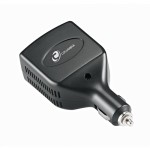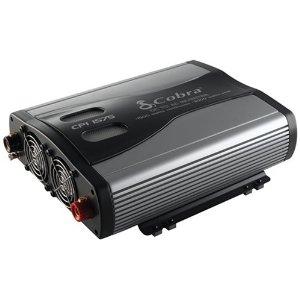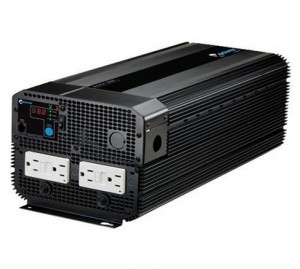At first glance, selecting an inverter to convert 12 Volt electricity in your battery bank to 110-115 volt “house” electricity is easy, right? Well, as with most things, nothing is easy. There are a lot of options and a lot of things to consider in your decision making/product selection. I certainly do not have all the answers but hopefully at least a few tidbits that help.
I suggest that the first question to answer is: What devices am I going to operate from the inverter?
 Normally we think of cell phone chargers, USB devices, even laptop computers but what about a coffee maker, small microwave oven, hair dryer, or even an electric drill? Yes, inverters exist that can power these devices. You may also wonder about televisions, stereo systems, and desktop computers. Again, the answer is yes.
Normally we think of cell phone chargers, USB devices, even laptop computers but what about a coffee maker, small microwave oven, hair dryer, or even an electric drill? Yes, inverters exist that can power these devices. You may also wonder about televisions, stereo systems, and desktop computers. Again, the answer is yes.
Finding the power requirements of most devices is as easy as looking at the back/bottom of the device and reading the label. However; some devices are requires some searching. Remember that the data listed on the label is the highest value. Many devices may draw the listed amount of power during start up but then taper down to a much lower amount. I use the listed value and know that I will have some leeway for normal operation. Be careful not to confuse cooking power and power draw of microwave ovens.
Some examples include:
- Small coffee makers: 600-750 watts
- Large coffee makers: 1000-1500 watts
- Small microwave oven: 600-1000 watts
- Small LCD Television: 200 watts (varies)
- PlayStation/Xbox: 200 watts
- DirectTV Receiver: 35 watts
- Magic Bullet: 250 watts
- 3/8 Electric Drill: 400-650 watts
My specific requirements include:
- Microwave Oven – 1000 watts – occasional use
- Coffee Maker – 600 watts – occasional/once per day use
- Laptop/Extra Monitor – 220 + 110 watts (max) – frequent use
Power inverters are rated for surge and continuous power output. Be careful with these numbers – some of the marketing/labeling is misleading. You may purchase a 750 watt inverter to run your 600 watt coffee maker only to find that the inverter is capable of only 500 watts continuous and is unable to run your coffee maker. Be sure that the inverter continuous power output of the device you purchase is adequate for your needs.
 The process of “inverting” DC power to AC power is not terribly efficient so there is a “cost.” This costs is some additional power. The rule of thumb that I’ve seen is a 10%-15% loss. This means that when we operate a device requiring 600 watts, the inverter is actually pulling about 660-675 watts of power from the battery bank. That doesn’t sound too bad but it is necessary to account for this when doing your electrical system calculations. The good news is that most of the typical high-wattage devices are either not used very long (hair dryer or microwave) or do not use this level of power continuously (coffee maker).
The process of “inverting” DC power to AC power is not terribly efficient so there is a “cost.” This costs is some additional power. The rule of thumb that I’ve seen is a 10%-15% loss. This means that when we operate a device requiring 600 watts, the inverter is actually pulling about 660-675 watts of power from the battery bank. That doesn’t sound too bad but it is necessary to account for this when doing your electrical system calculations. The good news is that most of the typical high-wattage devices are either not used very long (hair dryer or microwave) or do not use this level of power continuously (coffee maker).
The next issue is the quality of the power being output by the inverter. The less expensive inverters output a quality of power that cannot be used by some devices. You may hear several different terms. The more expensive “better” inverters output “pure sine wave” or “true sine wave” power. The less expensive inverters output “modified sine wave” power. The cheapest inverters output “square wave” power. The technical difference isn’t all that important. What is important is knowing that a number of electronic devices will not run well (or at all) on modified sign wave power. These devices are reported to include fax machines, laser printers, game systems, some medical equipment, plasma televisions, and high end audio/video devices. Some devices will run on less than true sine wave power but will be “noisy” (cracking sounds in audio or “lines” in video).
All of these details tend to lead you into the more expensive inverters and suddenly you find that a built in battery charger is an option (when connected to shore power). This is a slick deal as you get to consolidate some equipment.
Most inverters consume some amount of power when turned on, even when not inverting power (stand by or no load state). In some environments this is ok. On my boat with limited power generation and storage, this is not ideal. Due to limited space, I would really like to mount the inverter somewhere where space is not at a premium (like in a locker). This means limited access to the on/off switch. Thankfully, it appears that the manufacturers understand this and provide remote on/off switches for many of the 1000+ watt inverters.
You must consider your battery bank – especially when planning to operate devices that draw a lot of power (coffee maker, microwave, etc…). Do you have sufficient capacity? Depending on the type of batteries in use, their life can be significantly reduced by fast discharge and/or deep discharge. Now
the really ugly part. A 600 watt load at 110 volts is a mere 5.5 amps. However; that same load at 12 volts is 50 amps. This is what happens when we power
110 volt devices from a battery bank – the load is quite severe.
Finally, the wiring between the battery bank and inverter must be up to the task. For 800+ watt inverters, this usually means some pretty significant cables. A 2000 watt inverter with 6′ long cables (between inverter and battery bank) should be installed with #2 cables. This relates to the above point – this 800 watt at 110 volt load is pulling something around 70 amps at 12 volts (from your battery bank).
 As with so many things, this is an area where it is easy to go overboard. I would love to have a 5000 watt inverter with built in charger and all the bells and whistles. However; I have to stop and ask myself why. I would use this capacity once in a blue moon, if ever and the purchase/installation costs are high for this equipment. Before too long, I would begin thinking that I need a bigger/better battery bank and would sink more money into it. I have spent a lot of time trying to simplify and a decision such as this has to be made with that consideration in mind. To that end, the decision that I have made for my boat is to purchase reasonable quality 1500 watt (continuous) modified sine wave inverter with remote on/off switch. It will be mounted near the battery bank with a remote on/off switch. I will then run a 110 volt electrical line to permanent mounted 110 volt electric socket on both the port and starboard sides of the cabin. At the present time, I have no intention of adding a TV or other equipment that requires true sine wave. If I do, I will add an inverter to match. I really like the combined inverter/charger concept (from a space savings perspective) but I am not plugged into shore power enough to make this worth the cost.
As with so many things, this is an area where it is easy to go overboard. I would love to have a 5000 watt inverter with built in charger and all the bells and whistles. However; I have to stop and ask myself why. I would use this capacity once in a blue moon, if ever and the purchase/installation costs are high for this equipment. Before too long, I would begin thinking that I need a bigger/better battery bank and would sink more money into it. I have spent a lot of time trying to simplify and a decision such as this has to be made with that consideration in mind. To that end, the decision that I have made for my boat is to purchase reasonable quality 1500 watt (continuous) modified sine wave inverter with remote on/off switch. It will be mounted near the battery bank with a remote on/off switch. I will then run a 110 volt electrical line to permanent mounted 110 volt electric socket on both the port and starboard sides of the cabin. At the present time, I have no intention of adding a TV or other equipment that requires true sine wave. If I do, I will add an inverter to match. I really like the combined inverter/charger concept (from a space savings perspective) but I am not plugged into shore power enough to make this worth the cost.
This is the inverter that I am considering – a Cobra 1500.
I found these links helpful, you may too.
- http://www.whistlergroup.com/faq-inverters-answers.asp
- http://www.dcacpowerinverters.com/inverterguide.htm


I purchase a 400 watt inverter and it has a 12 adaptor that I have tried to use with the Magic Bullet that is 250 watts and it just stops and starts every second is this something wrong with my inverter, or my SUV 12v connector?
Howdy Mike! Tough to say for certain. My first guess is that the connected device is drawing more power than the inverter can provide. However; I wouldn’t think a device like that has much inrush current so that is unlikely. 250 watts is 20 amps @ 12.5VDC so it is possible that the inverter is connected to a source that is unable to supply the necessary 12VDC power??